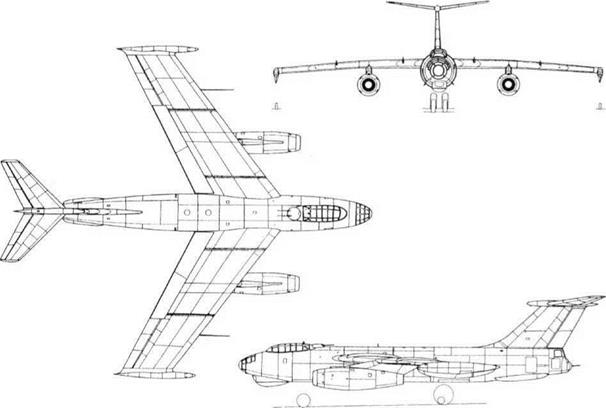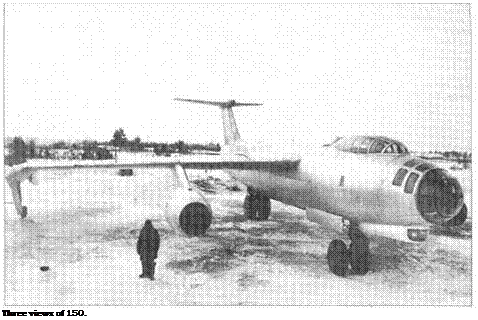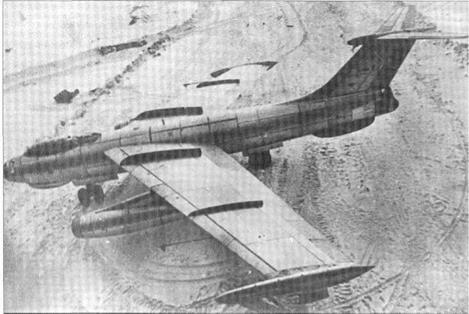Type 150
 |
Purpose: Experimental jet bomber.
Design Bureau: OKB-1, Podberez’ye and later at Kimry, General Director from October 1948 S M Alekseyev.
The first official history of OKB-1 to be published (in Kryl’ya Rodiny for December 1987, written by I Sultanov) stated that it was led by Alekseyev, whose own OKB had been closed, and that this aircraft was ‘designed in close collaboration with CAHI (TsAGI), the leading experts on aerodynamics and structures being V N Belyayev, AI Makarevskii, G P Svishchev and S A Khristianovich’. At the end it briefly noted that ‘a group from Germany, led by B Baade, participated…’ It would have been more accurate to explain that OKB-1 was specifically formed on 22nd October 1946 in order to put to use several hundred German design engineers, led by Prof Brunolf Baade and Hans Wocke, who had been forcibly taken with their families to a location 120km east of Moscow where they were put to work in a single large office block. For the first three years they were fully occupied on the Types 131 and 140 described previously. However, mainly because of doubts that the forward-swept wing would ever be
made to work, even before they left Germany they had completed preliminary drawings for a bomber of similar size but with a conventional backswept wing. By 1948 this had become an official OKB-1 project, called 150. The original Chief Designer was P N Obrubov, but Alekseyev took his place when he arrived. Workers were increasingly transferred to the 150, which grew in size and weight from the original 25 tonnes to produce a bomber intermediate between the IL-28 and Tu-16. The brief specification issued by the WS called for a take-off weight between 38 and 47 tonnes, a maximum speed rising from 790 km/h at sea level to 970km/h at 5km, a service ceiling of 12.5km and a range varying with bomb load from 1,500 to 4,500km (932 to 2,796 miles). Only a single flight article was funded, and this had to wait a year for its engines. At last it was flown by Ya I Vernikov on 14th May 1951. On Flight 16 on 9th May 1952 the aircraft stalled on the landing approach, and though the aircraft was marginally repairable nobody bothered, because of the clearly greater potential of the Tu-88 (prototype Tu-16). The dice were in any case loaded against a German-designed aircraft. In late 1953 Baade and most of the Germans re
turned to their own country, where in Dresden they formed a company called VEB which used the Type 150 as the [highly unsuitable] basis for the BB-152 passenger airliner.
A modern all-metal aircraft, the 150 had a shoulder-high wing with a fixed leading edge swept at 35°. As this wing had hardly any taper the tips were extraordinarily broad, leaving plenty of room for slim fairings housing the retracted tip landing gears. The concept of tandem centreline landing gears with small wheels at the wingtips had been evaluated with Alekseyev’s own I-215D. At rest the wing had anhedral of-4°, reduced to about -1° 20′ in flight. Each wing had two shallow fences from the leading edge to the slotted flap. Outboard were three-part ailerons. The fuselage was of circular section, tapering slightly aft of the wing to oval. Fixed seats were provided in the pressurized forward section for two pilots, a navigator/bombardier and a radio operator who also had periscopic control of a dorsal turret with two NR-23 cannon. Underthe floor was the RPB-4 navigation/bombing radar, with twin landing lamps recessed in the front. Behind this was the steerable twin-wheel nose gear. Next came the large bomb bay, 2.65m (8ft Sin) wide and high and 7m (23ft)
long, with a load limit of 6 tonnes (13,228 Ib). Next came the rear twin-wheel truck, which on take-off could be suddenly shortened to tilt the aircraft 3° 30′ nose-up for a clean liftoff. The large fin was swept at 45°, with a two-part rudder and carrying on top the 45°-swept tailplane and three-part elevators with dihedral of 8°. In the tail was a rear gunner with a turret mounting two NR-23 cannon. Under each wing was a forward-swept pylon carrying a Lyul’ka AL-5 turbojet rated at 4,600kg (lO. HOlb). A total of 35,875 litres (7,892 Imperial gallons) of fuel was housed in eight cells along the upper part of the fuselage, and additional tanks could be carried in the bomb bay. On each side of the rear fuselage was a door-type airbrake. Like almost everything else these surfaces were operated electrically, the high-power duplicated DC system including an emergency drop-out windmill generator. Each flight-control surface was operated by a high-speed rotary screwjack.

 Though flight testing revealed some buffeting and vibration, especially at full power at high altitude, the numerous innovations introduced on this aircraft worked well. Nevertheless, it would have been politically undesirable for what was essentially a German aircraft to be accepted for production. Thus, hitting the ground short of the runway was convenient.
Though flight testing revealed some buffeting and vibration, especially at full power at high altitude, the numerous innovations introduced on this aircraft worked well. Nevertheless, it would have been politically undesirable for what was essentially a German aircraft to be accepted for production. Thus, hitting the ground short of the runway was convenient.
|

|
|










